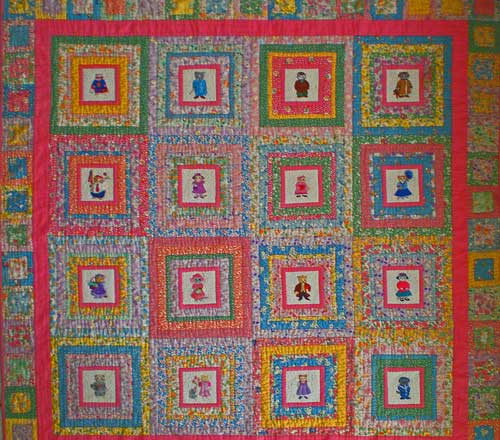This post contains affiliate links for which I receive compensation
Machine Quilting Flannel Quilts
I have made a flannel quilt and I am at the stage of quilting. What is the best way to quilt flannel? Free motion or ditch stitching?
Reply
Another quilt top finished! CONGRATULATIONS!!!As to which way to quilt it, well, that all depends on what you like to do best.
Ditch quilting...
...or stitching in the ditch, will get the machine quilting done without having to spend much if any time deciding on the quilting pattern. You just follow the existing piecing lines. That means no time spent marking either. Sounds great! But......it can get pretty boring. And for me at least, this kind of quilting always seems to take longer than expected. (Probably because it is boring!)
It adds very little texture your to quilt top, very little interest, but it is a perfectly acceptable way to finish your quilt—your three layers are held together and the quilt is stable. That is all you need really.
But girls just want to have fun!
Free motion quilting is just plain fun. Flannel is quite forgiving. Your stitches just naturally want to sink into it.If you like machine quilting and consider yourself to be a confident beginner when it comes to free motion stitching, then I suggest you combine the two—ditch quilting with free motion.
Yep. You read that right! Combine the two.
You CAN free motion ditch quilt.
And flannel is the perfect place to do it.
So drop those feed dogs and install your darning foot.
It will take a bit of time getting comfortable doing it this way. But it's worth the practice. You can quilt in any direction so there's fewer starts, stops and tying off...way faster.
Personally, when I ditch quilt anymore, that burning sensation between my shoulder blades always happens. Ugh! THAT cuts into my quilting time. Somehow, when that darning foot is on, I don't get that pain.
The first flannel quilt that I used this technique on is the Kitty Quilt (below). I also did another one, same pattern, with machine embroidered snowmen on it at about the same time. There was lots of room to practice.

The long straight lines along the outside of each block were quilted first to stabilize the quilt top. These long lines includes the seams on both sides of the larger outside pink border (not to be confused with the pink square around the embroideries.)
This was a great way to practice this technique. You know how to stitch on your machine. You are used to feeding your fabric from front to back. You have muscle memory on how it should feel. You also know how your machine sounds as it's making 10-12 stitches an inch as you piece.
Use what you already know to master this free motion technique.
Next was the outline quilting around the embroideries. This was to further stabilize the quilt top. The safety pins used for basting were removed as they got in the way.
Now came the concentric squares.
Each round of blocks forms a square. Each square was stitched in one continuous line. It was a great place to practice stitching forwards, backwards, left to right and right to left. (I found I had the most difficulty stitching free motion from left to right...I've spent some serious time practicing to get over that!)
Yes, absolutely was I tense when I was doing this for the first time. Didn't want to make a mistake...miss the ditch.
Did I miss the ditch?
Yes, absolutely! Lots of times. But I didn't rip anything out.
These are flannel quilts...that will get washed...a lot...and used up quicker than our regular quilts.
What mattered wasn't how 'perfect' I was. What mattered is that I practiced and learned a new technique.
I did.
And the flannel was forgiving...
...all of my 'missteps' out of the ditch are still there. But after washing, one really has to look for them. And that's not the purpose of this kind of quilt.Flannel quilts get used and worn out and loved. That's the purpose.
A word of caution...
Regardless of which method you choose to quilt your quilt, do take it slower as you stitch through the flannel seam allowances.Flannel is thicker than our traditional cotton quilting fabrics. You may find that your needle wants to 'jump' as it crosses the thicker parts where seam allowances meet.
Awareness that this can happen combined with stitching slower through those places will give you more control as you sew and a better finished product.
I hope this information has given you some ideas.
Flannel quilts are the greatest...warm and cozy, like being wrapped up in a hug!
Piecefully,
Julie Baird
Editor
P.S. If you're interested, this page tells a bit more about making the 'Kitty' baby quilt with machine embroidery shown above.














